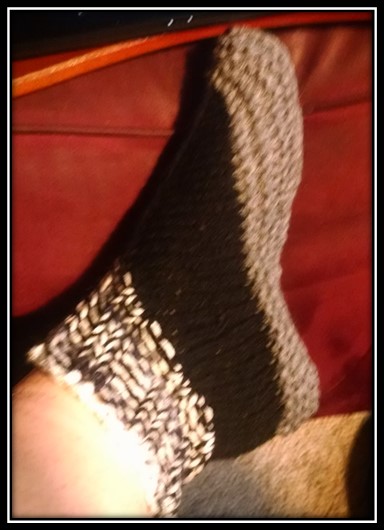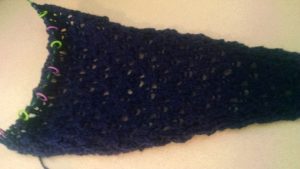 I am very proud of these slippers.
I am very proud of these slippers.
Would I show these on Ravelry, excited about the project and expecting congratulations on my knitting prowess?
No, I would not. The reason I am proud of these is a bit subtle.
They’re just slippers. They’re made out of leftover cheap acrylic yarn made on the spur of the moment because my husband’s old slippers had died and this was a way to get him some quickly. They’re not even interestingly awful, like something cruel, informed people would snark at a craft fair. They’re just something some old lady might make sitting irrelevantly in her rocking chair.
At least, that’s the cultural narrative.
They’re also the culmination of nearly 45 years of achieving mastery in several subjects.
You see, I didn’t open up any pattern book to make them, even though I’d never knit socks in that size or with that weight of yarn before. I didn’t even use a spreadsheet to do the calculations.
The learning process for these slippers started on a snowy day when I was a child. On snow days, because they were rare and had a holiday feel to them, my mother made cookies with my brother and I. But sometimes… Well, we’d want to make more cookies than the recipe on the back of the yellow Nestle’s bag of semi-sweet morsels. That’s when Mom taught us not only how to add, but how to add fractions.
The learning process continued as I got older and wanted to learn to write a computer program. My father didn’t let me turn a computer on. Oh, no. He handed me a pencil and paper and taught me to write out what I wanted to do with that program. That’s how I learned that thinking out the design phase of a project was important, even though I didn’t think of it that way in my grammar school mind.
On the learning process went, with math teachers explaining that fractions are really ratios and how to calculate, with my mother teaching me to sew garments and dozens of books on how to create proportional irregular shapes. It went on with me reading books on clothing and how design ease worked, and how much to create for different sorts of garments. It went on with learning how to knit, and learning from other books and other knitters various skills in creating garments and the ratios that tended to be consistent across body shapes. It went on with learning to use Excel as a tool to create garments so often that I memorized certain calculations.
On, until one day, my husband needed some slippers. I asked him to tell me how long his foot was. And then…
I just gathered up some leftover yarn, pondered for a moment about some ratios and I sat down to knit. I did it as casually as you’d drink a cup of coffee and tell your family about your day, with as little conscious thought as bringing in the mail.
People call things like manufacturing and garment work unskilled labor. I know better. I also wonder what other work is really a culmination of years of various studies that we dishonor like that.


 I overbought majorly on the aran weight cream colored wool for a sweater I made back at the beginning of the year.
I overbought majorly on the aran weight cream colored wool for a sweater I made back at the beginning of the year.









